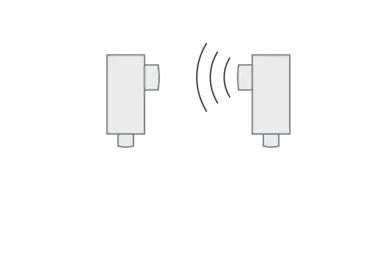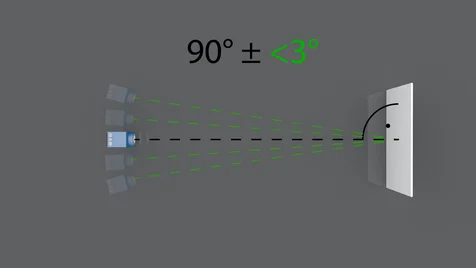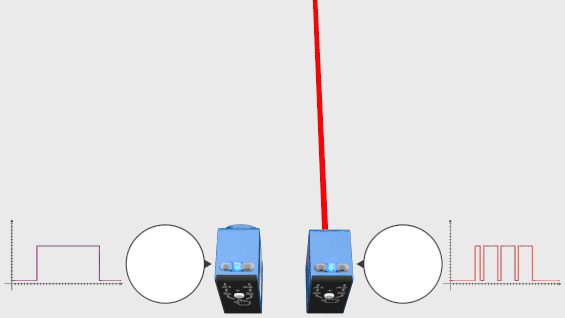What Are the Operational Principles of Ultrasonic Sensors?

Through-Beam Principle with Two Ultrasonic Through-Beam Sensors
With two ultrasonic sensors
In through-beam mode, two ultrasonic sensors are mounted facing each other. As a result, the emitter and receiver are directly across from each other and the signal sent by the emitter is tested to determine whether it has been detected by the receiver. With wenglor ultrasonic sensors, it is possible to set by means of parametrization whether this acts as an emitter or a receiver. In principle, it cannot measure distances, but rather detect or distinguish between objects.Fork Sensors for Label Detection
Ultrasonic fork sensors are special sensors that work according to the through-beam principle. They detect labels on any label material regardless of color, transparency or surface finish. The emitter and receiver are mounted directly across from each other, but are located in the same housing.How Does an Ultrasonic Sensor Work?
Functionality and Structure of an Ultrasonic Distance Sensor

Detect and Measure with One Sensor
An ultrasonic distance sensor detects objects in a contactless manner and measures the distance between the sensor and the measured object. To do this, it cyclically emits a short, high-frequency sound wave at the sensor head. This travels through the air at the speed of sound. If the sonic pulse encounters an object, this object reflects it back to the ultrasonic sensor. The ultrasonic probe then internally calculates the distance to the target object by measuring the time between the emission and reception of the sonic pulse.
Various Switch Outputs
Two independent digital switching outputs can be used to detect two positions (positioning sensor) or filling levels (fill level sensor). The actual distance/measured value can be output via an analog output – either as current (4…20 mA) or voltage (0…10 V). This same value can also be output via the IO-Link. The switching outputs can be configured as NPN (low side), PNP (high side) or push-pull.How Does an Ultrasonic Sensor Measure the Distance to the Object?

In this case, the distance L, the time it takes for the ultrasonic wave T to be emitted and received and the speed of sound C are used to form the equation.Distance L = ½ × T × C
What Operating Modes Does an Ultrasonic Sensor Have?

What Is a Through-Beam Mode?
Example from the field: Detecting a slide

What Is Synchronous Operation?
Example from the field: Detecting a long wooden board with no temporal offset (synchronous)

What Is Multiplex Mode?
Practical example: a large area of a liquid in a container is being monitored with regard to its level.
What Is the Difference Between Ultrasonic Sensors, Distance Sensors, Reflex Sensors and Fork Sensors?

wenglor ultrasonic expert Dominik Jeßberger knows the difference.
“Reflex distance sensors are also called ultrasonic reflex sensors, ultrasonic proximity switches or ultrasonic distance sensors. Different terms are used depending on the industry. Ultimately, these products are suitable for measuring or controlling distance, checking levels, as well as counting or detecting objects.
However, only ultrasonic fork sensors are suitable for detecting labels. This is due to their structural design: they have an extremely small fork width, a transmitter and receiver, and an elevated sound frequency.”
What Is a Sonic Cone?

What Is an Aperture Angle?
The surface structure of the measured object has no influence on the measurement result. This means uneven bulk materials, punched sheets with holes or moving and bouncing objects can be detected. Thus, for uneven surfaces, the aperture angle is set particularly wide, while for narrow and small surfaces, it is set particularly narrow.

What Happens If the Sonic Cone Is Larger than the Object?
To allow the ultrasonic sensor to measure the time between the transmitted and received signal, the object to be detected must reflect enough sound. The smaller the target’s surface area, the smaller the amount of sound reflected. If the object is too small, not enough sound can be reflected, which means the sensor can no longer detect the target. Therefore, sensors with a narrow sonic cone should be used for measuring small objects. Thanks to the focused sound beam, a large portion of the sonic energy then directly hits the object. As a result, almost the entire sonic energy can be reproduced by the target and perceived by the sensor. In general, it is not a problem if the target is smaller than the sonic cone. For the switching point, the sensor focuses on the earliest object it can detect.For detecting very small objects, photoelectronic sensors with laser light are the more suitable option.

How Is the Sonic Cone Affected by Accessories?
The ultrasonic sensor’s sonic cone can be affected if accessories are placed in front of the sensor’s active area. A soundpipe (or sonic tracker) is used to guide and narrow the sonic cone so that precise measurement is possible through small openings. The filling process in the food and pharmaceutical industries, in particular, requires exact fill level measurements in vessels with narrow openings such as bottles, cannulas or vials. The sonic tracker enables you to easily expand the ultrasonic sensor in the 1K miniature design without changing the installation size (32 × 16 × 12 mm).Can the Ultrasonic Cone Be Redirected?


What Is an Oscillator in an Ultrasonic Sensor?
In an ultrasonic sensor, the sensor surface on which the sound signal is generated is referred to as an oscillator, active surface, ceramic converter or transducer. Since this surface vibrates, the sensor is resistant to contamination to a certain degree: Dirt and grime do not stick to the oscillator, but instead are blown away by the fine movements.Advantages of Ultrasonic Sensors

Excellent Background Suppression

Detection of Almost All Materials

Wide Range of Distances

Resistant to Interfering Influences
What Objects Do Ultrasonic Sensors Detect?
Ultrasonic distance sensors measure distances precisely, regardless of material, surface, color or transparency.
Detect almost any object

Dust, mist and dirt resistant

Detect complex forms

Object Detection in Aggressive Media and Foam

Which Objects Cannot Be Optimally Detected by Ultrasonic Sensors?
- Soft material like cotton, fabrics, foam rubber or felt absorb the sound or diffusely reflect the sound. As a result, an ultrasonic sensor passes through the soft material and the hard surface (e.g. the table behind it) is detected instead.
- Objects with an extremely high temperature result in the echo only reaching the sensor head diffusely or not at all.
- Environmental factors such as air turbulence can have an impact on echo quality and therefore also the measurements. The ambient temperature influence is canceled by temperature compensation.
Sectors and Industries Which Use Ultrasonic Sensors
Possible Uses for Ultrasonic Sensors
Controle de presença
Film Tear Monitoring
Controle de nível de enchimento
Controle de flexão
Robot positioning
Monitoramento da altura da pilha
Label detection
End position control
Through-Beam Sensor
Positioning
What Should Be Taken into Account when Installing Ultrasonic Sensors?

General Use
- When installing ultrasonic reflex sensors, avoid heavy dirt deposits on the active surface (transducer).
- The active surface (oscillator) of the sensor must remain free.
- The product must be protected against mechanical impact.
- Make sure that the sensor is mounted in a mechanically secure fashion.
This image illustrates the optimal installation of an ultrasonic sensor. For very hard and smooth objects, the angle between the sound axis and the object surface should be within 90° ± 3°. The angle can be larger for most object surfaces.
Effects of External Influences
Air flows such as wind, drafts and compressed air can influence ultrasonic sensor measurements under certain conditions. However, for modern ultrasonic sensors, these special impairments are minor in conventional industrial environments. Can You Hear Ultrasonic Sensors?
Although ultrasound is not audible to the human ear, ultrasonic sensors do generate low-frequency noise during operation by emitting sound packets. With modern ultrasonic sensors, the oscillator’s vibration is almost completely inaudible.What Is the Difference Between Ultrasonic Sensors and Optical Sensors?

Object Detection
Ultrasonic sensors use sound waves for detection, while optical sensors typically use infrared light, red light, blue light or laser light. One key difference is the size of the query area. The specific application determines which sensor is ideal for the task.Capture Speed
Since the speed of light is greater than the speed of sound, an optical sensor measures faster than an ultrasonic sensor.










































 Any questions?
Any questions?